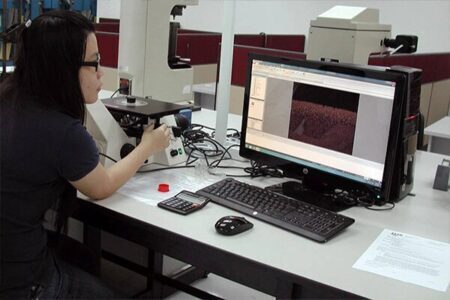Corrosion Analysis- Metallurgical Evaluation
CORROSION ANALYSIS
Corrosion analysis refers to the process of assessing and measuring the degree of corrosion that has occurred in a metal or alloy. This is typically done through visual inspection, physical testing, and analysis of the material's properties. Metal components fail due to the environmental conditions to which they are exposed, as well as the mechanical stresses they experience. Often a combination of both environmental conditions and stress will cause failure.
The goal of corrosion evaluation is to identify the extent and type of corrosion damage, determine the underlying causes, and develop a plan to prevent or mitigate future corrosion. The information obtained from corrosion evaluation can be used to make informed decisions about the maintenance, repair, and replacement of corroded materials or structures.
Manufacturers and their suppliers require verification of materials to produce components exposed to corrosive environments. IMR’s corrosion testing lab provides a complete array of metallurgical techniques to detect material properties and characteristics accurately.


TYPES OF CORROSION ANALYSIS
Metallurgical analysis and microstructural inspection are essential methods for evaluating the corrosive effects of metallic materials.
Metallurgical Analysis
Metallurgical analysis examines the structure and properties of metals and alloys. This involves studying the material's microstructure through various techniques, such as microscopy, to identify the type of phases present, grain size, and distribution of elements within the material. Metallurgical analysis is used to understand the behavior of materials under different conditions and to assess their suitability for specific applications. It is also used to diagnose and understand the causes of failures in metal components.
Microstructural Inspection
Microstructural inspection is a technique used to examine the microscopic structure of a material. It involves analyzing the size, shape, and distribution of the grains or phases within a material and any defects or features present at the microscale. Microstructural inspection can be performed using various techniques, including optical microscopy, scanning electron microscopy, and transmission electron microscopy. This type of analysis is often used in materials science and engineering to study the microstructure of materials and understand their properties and behavior under different conditions. In corrosive effects, a microstructural inspection can help identify the mechanisms of corrosion and the extent of damage to a material.
CORROSION TESTING METHODS
Dezincification Australian Std
Dezincification is a type of corrosion that can occur in brass alloys, and this test method is for evaluating the resistance of these alloys to dezincification under certain conditions.
Electrochemical Corrosion Testing
Evaluating a material's corrosion resistance by analyzing its electrochemical behavior in a simulated corrosive environment.
Environmental Stress Cracking (ESC)
Used to determine the susceptibility of a material to cracking when exposed to a specific environment and stress, the test involves subjecting the material to stress while it is in contact with a corrosive environment.
Evaluation of Duplex Stainless Steels
Assessing the corrosion resistance and susceptibility of steels in different environments and conditions, important for determining the durability and reliability of duplex stainless steels in various industrial applications, as well as for identifying potential issues or weaknesses that may need to be addressed in order to optimize their performance and longevity.
Formicary (Ant’s Nest) Corrosion
Evaluate the susceptibility of copper tubes to internal corrosion caused by the formation of formicary corrosion, the test involves exposing copper tubes to an environment containing the organic compounds and measuring the extent of corrosion after a specified period of time.
Galvanic Corrosion of Medical Implants
Evaluates the performance and safety of medical implants made of dissimilar metals that are in contact with each other and in the presence of an electrolyte solution such as bodily fluids.
General Corrosion Testing
Testing for general corrosion as a type of uniform corrosion that occurs on the entire surface of the metal, resulting in a uniform loss of material over time.
Pitting Corrosion Testing
Testing for pitting corrosion as a localized corrosion that occurs on the metal surface, resulting in small pits or holes, which occurs due to the formation of local anodic sites on the metal surface.
Heat & Fluid Aging
Process of subjecting a material to high temperatures and corrosive fluids to simulate the effects of aging and exposure in real-world conditions. This type of testing is commonly used for evaluating the long-term durability and resistance of materials.
Laboratory Immersion Corrosion Testing
involves immersing a sample of the material being tested into a solution that mimics the corrosive environment the material is expected to encounter in real-world applications. The sample is typically left in the solution for a specified period of time and then evaluated for signs of corrosion damage. This type of testing can be used to assess the corrosion resistance of materials and to compare the performance of different materials in the same environment. It can also be used to evaluate the effectiveness of corrosion inhibitors and coatings.
Mercurous Nitrate Testing
Used to determine the susceptibility of certain copper alloys to mercury corrosion. The test involves exposing the copper alloy specimen to a mercurous nitrate solution and observing the formation of a grayish-black film, which indicates the presence of mercury corrosion.
Moist Ammonia Vapor Testing
Type of accelerated corrosion test used to evaluate the susceptibility of copper and copper alloys to stress corrosion cracking in an ammonia-rich environment. The test involves exposing the specimen to moist ammonia vapor under controlled conditions of temperature, humidity, and ammonia concentration.
Passivation Testing of Medical Components
Process that evaluates the effectiveness of the passivation treatment on medical devices or components. The testing typically involves exposing the passivated medical components to harsh environments, such as saline solutions, to ensure that they will not corrode or degrade during actual use.
Potentiodynamic Corrosion
Widely used method to determine the corrosion resistance of metallic materials. This test involves measuring the current that flows between two electrodes (the sample and a reference electrode) while the potential difference between them is varied over time. By plotting the resulting data on a polarization curve, the corrosion potential and corrosion current density can be determined. This information can be used to evaluate the corrosion resistance of a material and to compare the effectiveness of different corrosion prevention methods.
Susceptibility to Stress CorrosionTesting
This test involves exposing the material to a corrosive environment while applying a tensile stress to the sample. The test is designed to simulate the conditions that the material may encounter during its service life. The test evaluates the ability of the material to resist cracking under the simultaneous effect of corrosion and stress. This test can be particularly applied to copper alloys.
Sensitization Testing
Assesses the susceptibility of stainless steel to intergranular corrosion (IGC) and intergranular stress corrosion cracking (IGSCC). Sensitization occurs when the chromium in stainless steel combines with carbon, forming chromium carbides at grain boundaries. This depletion of chromium at the grain boundaries can lead to IGC and IGSCC. Sensitization testing involves exposing the stainless steel to high temperatures for a specified time, followed by rapid cooling. The material is then subjected to a chemical or electrochemical test to detect any signs of IGC or IGSCC. The results of sensitization testing can help determine the appropriate heat treatment and material selection for stainless steel components to prevent corrosion.
Slow Strain Rate Testing
Involves applying a tensile load to a test specimen while exposing it to a corrosive environment. The goal is to determine the susceptibility of the material to stress corrosion cracking under a slow strain rate. The test involves applying a constant deformation rate to the specimen, typically around 0.05 to 0.5 mm per minute, and monitoring the evolution of cracks and other signs of corrosion.
Stress-Corrosion of Titanium Alloys
Used to evaluate the susceptibility of these alloys to cracking when exposed to specific environmental conditions. The testing involves subjecting the material to a controlled stress while exposing it to a corrosive environment, such as saltwater or acidic solutions. The test helps determine the critical stress intensity factor (KISCC), which is the stress level required to initiate a crack in the material.
U-Bend Stress Corrosion Sample Preparation
Used to evaluate the susceptibility of a material to stress corrosion cracking. In this test, a metal specimen is bent into a "U" shape and immersed in a corrosive solution. The combination of the applied stress and the corrosive environment can cause stress corrosion cracking to occur.
Corrosion Testing Methods: ASTM and ISO Standards
- AS 2345: Corrosion of Metals: Resistance to Stress Corrosion Cracking
- ASTM A226: Standard Practices for Detecting Susceptibility to Intergranular Attack In Austenitic Stainless Steels
- ASTM B154: Standard Test Method for Mercurous Nitrate Test for Copper Alloys
- ASTM B858: Standard Test Method for Measurement of Time-of-Wetness on Surfaces Exposed to Wetting Conditions as in Atmospheric Corrosion Testing
- ASTM F945: Standard Test Method for Compressibility and Recovery of Gasket Materials
- ASTM G30: Standard Practice for Making and Using U-Bend Stress-Corrosion Test Specimens
- ASTM G31: Standard Practice for Laboratory Immersion Corrosion Testing of Metals
- ASTM G36: Standard Practice for Evaluating Stress-Corrosion Cracking Resistance of Metals and Alloys in a Boiling Magnesium Chloride Solution
- ASTM G46: Standard Guide for Examination and Evaluation of Pitting Corrosion.
- ASTM G47: Standard Test Method for Determining Susceptibility to Stress-Corrosion Cracking of 2XXX and 7XXX Aluminum Alloy Products
- ASTM G48: Standard Test Methods for Pitting and Crevice Corrosion Resistance of Stainless Steels and Related Alloys by Use of Ferric Chloride Solution
- ASTM G123: Standard Test Method for Evaluating Stress-Corrosion Cracking of Stainless Alloys with Different Nickel Content in Boiling Acidified Sodium Chloride Solution
- ASTM G129: Standard Practice for Slow Strain Rate Testing to Evaluate the Susceptibility of Metallic Materials to Environmentally Assisted Cracking
- ISO 6509-1: Corrosion of Metals and Alloys -- Determination of Dezincification Resistance of Copper Alloys with Zinc
- ISO 12614-2: Safety Requirements for Compressed Hydrogen Fuel Cell Vehicles
RELEVANT ACCREDITATIONS
Click here for a complete list of accreditations and certifications for all IMR Test Labs locations.


